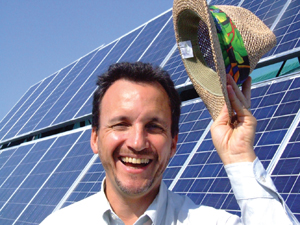For nearly half of the world’s population the modern conveniences requiring electricity have been out of reach because they live too far from the grid. But it now looks like innovative technology combined with creative new business models could change all that and significantly improve the quality of life for untold millions.

Based in southern Brazil, Fabio Rosa and the IDEEAS Foundation have demonstrated a small scale renewable energy system that could ensure villages all over the world have access to radios, lights, refrigeration and other critical technologies. The potential implications in terms of health, education and the general standard of living for millions of people are staggering. Mr. Rosa was recently in Toronto to receive an award from Ashoka Canada, honouring his work in bringing power to rural Brazil. This, on top of a grant of $50,000 from the U.S. Solar Development Foundation, is expected to launch Mr. Rosa’s project out of the demonstration stage and into rapid deployment. It’s an entire field of potential electric power development that has been completely “off the map” for most power companies.
The basic model is as simple as it is unconventional. Forget all the power lines, high voltage equipment and economies of scale achieved through large machines. Set up small solar panels in a good location in a village or on a farm, use them to charge up equipment that’s on-site or portable, and achieve economies of scale through mass production of many similar units. Forty-two farms in Brazil have their local solar systems installed already. As a result, Mr. Rosa feels well-positioned to start a major roll-out.
The basic model is built on a careful calculation of what a typical rural farmer or villager expects to spend on energy. Off-grid farm families could easily find themselves spending more than $12 per month on kerosene lamp fuel, diesel generator fuel, candles and batteries. When this expenditure is redirected into payments to lease a standardized solar power system, the families can save money every month while benefiting from much better energy services. The standard system installed by the Foundation’s project costs about $1200 for the solar panel, battery, household wiring, lights, plugs and monitoring processor. For $400 more, another panel sufficient to support a refrigerator can be added to the system. Another variation on the system allows a farmer to pump water for agricultural purposes or to wire up an electrical fence to ensure cattle use the land efficiently and don’t pollute local water supplies. Rosa says that the use of solar powered electrical fences can significantly increase the production of meat or milk from livestock because the relatively light weight equipment can be easily moved from paddock to paddock on a daily basis to control both the level of grazing and the distribution of manure.
The Ashoka Foundation is a nonprofit organization operating in over 70 countries with the objective of encouraging social entrepreneurship. It estimates that its activities support the work of over 2,000 social entrepreneurs. On November 15, Ashoka Canada, which is the official sponsor of Mr. Rosa’s Amazon project, in co-operation with Canadian Solar Inc., announced a donation of $100,000 to Mr. Rosa’s project. The $100,000 will be deployed over 3 years to ‘power up’ two villages on the Rio Tapajos, a tributary to the Amazon near Santarem. The donation of $100,000 to IDEAAS originated with former APPrO director Paul McKay, through Ashoka Canada. It will be used to install solar-powered public infrastructure (water pumping, school, Internet station) and to provide 70 solar lanterns for children. The donation is not tied to the use of panels from any one vendor.
Rosa established an independent non-profit organization in 2001 called the Instituto Para O Desenvolvimento De Energias Alternativas E Da Auto Sustentabilidade (IDEAAS). It is through the IDEAAS organization that much of his work on rural electrification is now being deployed. The dissemination of village-sized community power systems is actually Mr. Rosa’s second major effort in rural electrification. Twenty years ago he was responsible for another program in Brazil that overcame countless barriers to install low-cost 12 volt systems in approximately 2000 farm locations. Despite being seen as heretical and “unapproved” for many years, that program is now considered a great success. However, the system Rosa is working on today is designed for more than just farms, and it takes advantage of the latest advances in solar photovoltaics and integrated circuitry.
Mr. Rosa says, “The sun is shining for this project, for this new business model. … Solar energy is not expensive if it is leased as an energy service, instead of sold as a machine. That way millions can live in the modern world instead of the 19th Century.” It may prove to be true that new technology, combined with an innovative business model, could bring electricity to millions more people than ever before. Maybe billions.
For more information, see “Working Wonders: Revolutionizing Rural Power Supply in Brazil with Renewables” by Paul McKay, originally published in the Ottawa Citizen (March 2008) and reprinted at this location on the OSEA website: http://www.cpconference.ca > Program and scroll down to access this link to Paul McKay's story on Fabio Rosa .
